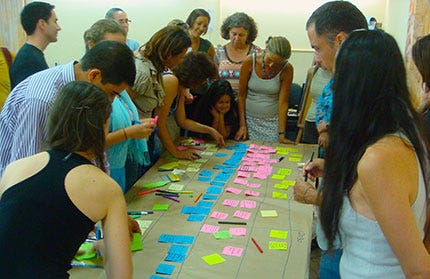Excerpt from the ‘Social Dimension’ of Gaia Education’s online course in ‘Design for Sustainability’
Any system with three or more interacting variables is a complex dynamic system. In each human being a myriad of biological, psychological, and physical variables interact constantly. Therefore we can regard human beings as complex systems, and any group of two or more of these systems is thus also a complex system.
From this perspective, groups are complex, adaptive, dynamic systems of interacting individuals. The members are the basic components of the system, who are coupled to each other by relationships. Like all living systems, groups can be self-creating and self-organizing systems (autopoietic systems). Groups may develop spontaneously as individuals begin to act in coordinated, synchronized ways.


Just like all living systems receive inputs from the environment, process this information and resources internally, and then output their products, groups gather information, review that information, and generate products.

Groups are also responsive to information concerning the context in which they operate and their impact on that context, and will adapt in response to feedback about the efficacy of their actions.
Seen as complex, adaptive, and dynamic systems, groups:
- Are nested open systems. Groups interact with the smaller systems (i.e., the members) embedded within them and the larger systems (e.g., organizations, communities) within which they are embedded;
- Have fuzzy boundaries that both distinguish them from and connect them to their members and their different contexts — organizations, communities, and physical and cultural environments;
- Change their structure and behaviour over time, yielding temporal patterns of development. Change is driven in part by the effects of experience and history, and in part by the group’s adaptive response to the impact of events;
- Contain feedback loops that create non-linear effects. Both negative (damping) and positive (amplifying) feedback are always found in groups as complex systems. A small change in a local variable that triggers a positive feedback loop can ultimately result in a big change at the global level;
- Are shaped by unobservable, but influential, emergent structures and properties. Interactions between members are based on the idea of coordination — members in a group must adjust to one another interpersonally to coordinate goals, understanding, and action. As a result of many cycles of interaction, patterns emerge that give rise to group-level properties and structures that define the overall dynamic of the group. Influential variables in a group can include written and unwritten norms that dictate behaviour, expectations about member’s roles, and networks of connections among the members (like status, attraction and communication networks).
WRITTEN BY
